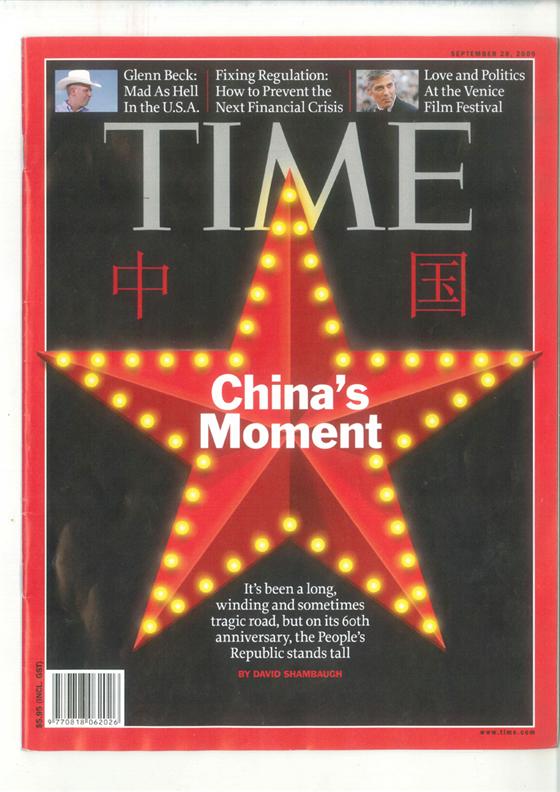今天,我偶然得到了一本9月28日出版的美国《时代》杂志(英文版)。这期杂志的封面文章是关于中华人民共和国建国60周年的。文章的标题是China's Moment醒目地印在亮着霓虹灯的大红五角星上。标题下有这样一段文字:
It's been a long,winding and sometimes tragic road, but on its 60th anniversary, the People's Republic stands tall(这是一条漫长而曲折的道路,有时还出现过悲剧,但在它的60周年中,中华人民共和国巍然屹立)。看看美国的著名杂志对中华人民共和国60周年的评述,我觉得很有意义,于是赶快把它翻译成中文,供大家欣赏。正所谓“奇文共欣赏,疑义相与析”。
现在发的是第一篇文章《富强之路》。
It's been a long,winding and sometimes tragic road, but on its 60th anniversary, the People's Republic stands tall(这是一条漫长而曲折的道路,有时还出现过悲剧,但在它的60周年中,中华人民共和国巍然屹立)。看看美国的著名杂志对中华人民共和国60周年的评述,我觉得很有意义,于是赶快把它翻译成中文,供大家欣赏。正所谓“奇文共欣赏,疑义相与析”。
现在发的是第一篇文章《富强之路》。

富强之路
值此建国60周年之际,中华人民共和国值得庆祝。但新兴的全球力量之旅才刚刚开始。
60年前,毛泽东站在天安门城楼上,面对人山人海,用高亢的湖南方言宣布,中华人民共和国建国和“中国人民从此站起来了!”这是一个充满自豪和希望的时刻。这个时刻宣告了中国共产党人的胜利,他们与日本侵略者进行了艰苦卓绝的斗争,推翻了国民党政权,结束了外国侵略者对中国领土长达一个世纪的占领。此外,毛泽东和中国共产党(CCP)是在没有重大外部支持的情况下夺得政权的,他们基本上是一个土生土长的革命。
毛泽东为中国带来了历代改革者(从19世纪的清朝到这一天)期望的愿景:恢复中国的富强、尊严、国际社会尊重和领土完整。在这方面,毛泽东和中国共产党直接反映了中国人民内心深处的渴望,从而赢得了他们的忠诚和党的合法性。他的继任者并没有动摇这一独特的理念和使命。
可悲的是,毛泽东把复兴强国和实现现代化的信仰与把中国变成社会主义的革命社会的理想愿望交织在一起。毛泽东的社会工程用无情的政治运动,抽筋似地不断震动中国。这些运动破坏了生产力,造成了可怕的生命损失。然而,尽管混乱,中华人民共和国却始终屹立并实现了工业化。60年来,通过许多措施,中国在成为全球的主要的力量方面取得了重大进展。毛泽东可能会承认,但他不会完全满意。
值此中华人民共和国成立60周年之际,似乎有许多值得庆祝。中国是世界上人口最多、人民勤劳的国家,是世界第三大经济体和贸易国,已成为全球科技创新基地,正在建设世界一流大学系统。它拥有日益现代化的军事力量,在外交方面赢得了国际社会的尊重。它与邻国和各大国和平共处。它的混合模式的准国家资本主义和半民主的独裁主义(有时被称为“北京共识”)已引起整个发展中世界的关注。
2008年的奥运会和明年将同样耀眼的上海世博会,使中国不断增长的软实力得到了进一步的加强。10月1日在北京举行的建国60周年庆祝活动将震撼世界,如果不是威慑的话,这种震撼来自引人注目的军事硬件和士兵方队。
中国进入了高速发展时期,随着时间的推移将更加明显。在过去的30年中,我每年到中国访问或居住,有机会目睹了中国戏剧性的改革。1979年我第一次到中国时,文化大革命的残余仍然明显:很多墙上涂着革命口号,大学的建筑物上布满了弹洞,这些弹洞是红卫兵武斗时发射炮弹和子弹所遗留下来的。当时我看得出知识分子和官员们竭力掩饰的心理伤痕。我听到了许多知识分子和官员遭受羞辱和殴打、失去住所和财产、被强迫劳动的故事。
然后,我亲眼目睹了中国在二十世纪八十年代中个人自由和经济增长方面的戏剧性变化。九十年代中期,邓小平点燃了国内经济改革,中国在世界上的地位已经正常化。但是,政治上的高压仍然存在。只是在最近10年中,在江泽民时代的后期和在胡锦涛的领导下,中国共产党开始了非常有限的政治改革试验。我和那些参与各种“民主”改革的共产党官员的讨论使我弄清楚了,他们的改革有严格的界限。
从中华人民共和国整个60年的历程来看,成绩和不足是混杂在一起的。它所取得的巨大成就和这些成就所暴露出来的矛盾形成了鲜明的对比。在许多部门,每一项改革都会带来新的问题和挑战。中国走过了漫长的道路,但它仍然有很长的路要走。
The Road to Prosperity
As it marks its 60th birthday, the People's Republic of China has much to celebrate. But the emerging global power's journey has barely begun
Sixty years ago Mao Zedong stood before a sea of people atop Tiananmen Gate proclaiming, in his high-pitched Hunan dialect, the founding of the People’s Republic of China and that the “Chinese people have stood up!” The moment was marked with pride and hope. The communists’ victory had vanquished the Nationalist regime, withstood the vicious onslaught of the Japanese invasion and overturned the century of foreign encroachment on China’s territory. Moreover, Mao and the Chinese Communist Party (CCP) came to power without significant external support—theirs was largely a homegrown revolution.
Mao brought a vision for China that has resonated from the 19th century Qing dynasty reformers to this day: to regain China's fu qiang (wealth and power), dignity, international respect and territorial integrity. In this regard, Mao and the CCP positioned themselves squarely with a deep yearning among Chinese—thus earning their loyalty and the party's legitimacy. His successors have not wavered from this singular vision and mission.
Tragically, Mao’s belief in restoring china’s greatness and achieving modernity was inextricably intertwined with his ideological desire to transform. China into a socialist and revolutionary society. Mao’s social engineering continually convulsed China in unrelenting political campaigns. These movements disrupted productivity and caused horrific loss of life. Yet despite the chaos, the People’s Republic embarked on industrialization and stood up. By many measures, 60 years on, China has achieved significant progress toward becoming a major and global power. Mao may recognize it, but he would not be wholly happy with it.
As the people’s Republic of China commemorates its 60th anniversary, it seemingly has much to celebrate. China is the world’s most populous and industrious nation, is the world’s third largest economy and trading nation, has become a global innovator in science and technology, and is building a world-class university system. It has an increasingly modern military and commands diplomatic respect. It is at peace with its neighbors and all major powers. Its hybrid model of quasi-state capitalism and semidemocratic authoritarianism —sometimes dubbed the “Beijing Consensus”—has attracted attention across the developing world.
This growing soft power of China was strengthened by the 2008 Olympics extravaganza, and the Shanghai Expo next year will similarly dazzle. The 60th anniversary celebration in Beijing on Oct.1 will impress, if not frighten, the world with an arresting display of military hardware and goose-stepping soldiers. Less visible is the fact that China is the first major economy to recover from the global recession and, indeed, is leading the world out of it.
China is on a roll, particularly when viewed over time. Visiting or living in China every year over the past three decades, I have had the personal opportunity to witness dramatic transformations. When I first went to China in 1979, vestiges of the Cultural Revolution were still evident: revolutionary slogans painted on walls and pockmarks on university buildings from bullets and howitzer shells shot by dueling Red Guards. Camouflaged, but just as evident, were the personal scars borne by intellectuals and officials whom I met at the time. I heard stories of beatings and humiliations, confiscations of personal possessions and loss of living quarters, and forced hard labor.
I then witnessed the dramatic blossoming of personal freedoms and economic growth in the 1980s, punctuated by periodic countercampaigns launched by neo-Maoists in the leadership. One could literally feel and see Chinese society come alive after its long Maoist trauma, only to have people quickly recoil when seesaw pattern persisted throughout the decade, culminating in the dramatic Tiananmen demonstrations and their suppression in June 1989.
In the early 1990s, I again experienced China as a society traumatized, this time by the aftermath of Tiananmen. But by mid-decade Deng Xiaoping had reignited domestic economic reforms and China had normalized its place in the world after its post-Tiananmen isolation. Politics, however, remained frozen and the heavy hand of the state remained evident. Only during the present decade, in the waning years of Jiang Zemin’s rule and under Hu Jintao, has the Communist Party begun to experiment with very limited political reforms. My discussions with those party officials involved with crafting the “democratic” reforms makes clear that there are strict boundaries to how far they will proceed.
Thus, when considering the totality of six decades, the record of the PRC is decidedly mixed. While its achievements have been momentous, so are the contrasts and contradictions exposed by those very same achievements. In many sectors, each reform. breeds new problems and challenges. China has come a long way, but it still has a long way to go.
